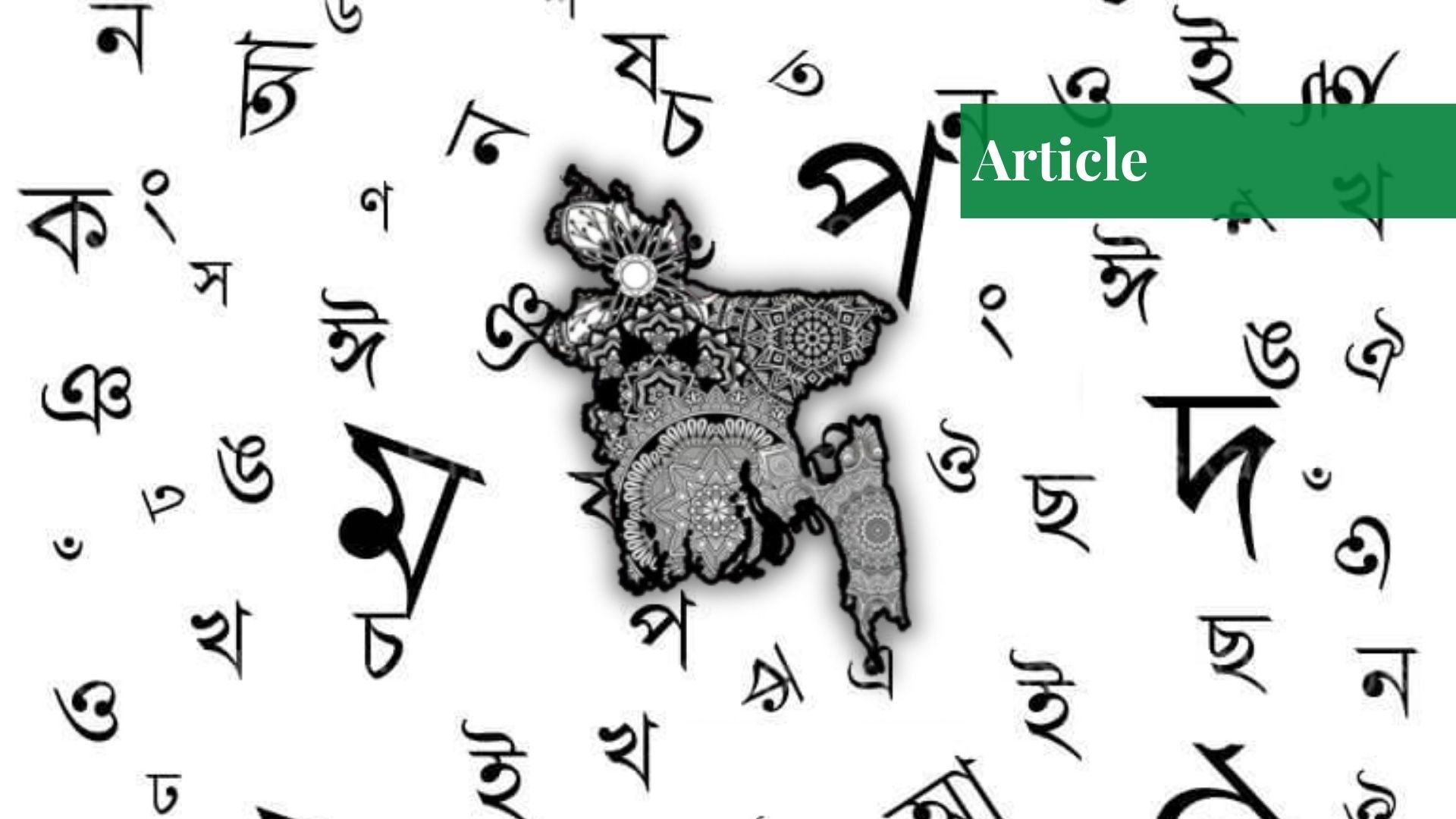In 1974, the renowned Urdu poet Faiz Ahmed Faiz accompanied Pakistan’s then prime minister, Zulfikar Ali Bhutto, on an official visit to Dhaka. However, the trip did not unfold as Faiz had expected—many of his Bengali peers refused to meet him. Saddened by their absence, he penned his now-famous ghazal “Dhaka Se Wapsi Par,” lamenting, “What you had gone to say, Faiz… /After everything was said, that still remained unsaid.” Though Faiz mourned his own inability to articulate something meaningful, his words echo a deeper truth about the historical relationship between Pakistan and Bangladesh—a history marked by silenced voices, unspoken grievances, and linguistic oppression.
The question of language was at the forefront of the Bangladesh Liberation War, and to this day, it remains central to Bengali society. It is a linguistically diverse country. Although over 40 languages are spoken in Bangladesh, the de facto official language is Bengali. According to some sources, over 98% of the country speaks standard Bengali or one of its dialects.
Types of Languages Spoken in Bangladesh
Languages spoken in Bangladesh can be divided into two main groups: Aryan and non-Aryan.
Aryan Languages
Aryan languages belong to the Indo-European languages. They are the easternmost branch of the family. They are also the largest part of the family. Bengali is an Aryan language, evolving from the eastern Middle Indo-Aryan branch. These languages are spoken in the lowlands of the country. These languages are sometimes considered distinct but are often classified as Bengali dialects. Some of the languages belonging to this group are Bishnupriya, Chakma, Chittagongian, Sylheti, and Rohingya.
- Bishnupriya
Bishnupriya is spoken in the Sylhet region of the country. It uses the Bengali alphabet.
- Chakma
Chakma is a regional language spoken by almost 310,000 Bangladeshis living near Chittagong city. It has its own script for writing—the Chakma script.
- Chittagonian
Chittagonian, spoken in southeastern Bengal, is primarily used in the city of Chittagong. Chittagonian and Bengali are not mutually intelligible, but, nonetheless, it is considered a dialect of the latter. It is spoken by almost 13 million people.
- Sylheti
Sylheti is spoken in the Sylhet division of Bangladesh. There is debate as to whether it is a language of its own or a dialect of Bengali. However, both languages do share almost 80% vocabulary.
- Rohingya
Rohingya is the language of the people of the Arakan State of Burma. It was brought to Bangladesh by the Burmese refugees – hence, it is a migrant language, one of the main ones in the country.
Non-Aryan Languages
The non-Aryan languages include Austroasiatic languages such as Khasi, Koda, Mundari, and Pnar. They also include two Dravidian languages – Kurukh and Malto. The Tibeto-Burman languages also belong to this—some of these include the Chak, Garo, and Tripuri languages. These languages belong to minority groups, and many are considered to be indigenous languages by their speakers.
The Dominance of Bengali – the Official Language of Bangladesh
Despite Bangladesh’s linguistic diversity, only one voice dominates, creating ripples across its societal fabric. The voice is that of the Bengali language, the national language of Bangladesh. According to a paper by Amena Mohsin titled ‘Language, Identity, and the State in Bangladesh,’ the language policies of Bangladesh are deeply discriminatory, having an obvious hegemonic bias towards the Bengali language, sidelining the many indigenous languages that are spoken in the country. This has contributed significantly to Bengali becoming a widely spoken language among the people in Bangladesh.
Mohsin writes that “no one knows the exact number of non-Bengali communities in Bangladesh”; the 1991 census of Bangladesh puts this number at twenty-nine. However, the members of the minority communities claim that there are more than forty-five non-Bengali communities in the country—this points towards the state’s ignorance and silencing of the non-Bengali voices.
According to Mohsin, “The non-Bengali communities of Bangladesh can be divided into two main groups…: the Plains groups and the Hill groups.” The relationship between the Bengali and the non-Bengali communities is not ideal—it is a relationship of “mistrust,” writes Mohsin. This mistrust and discrimination are symptoms of a model of nationalism adopted by the Bangladeshi state. After independence, Bengali was made the national language, and it was essential to the idealized notion of a Bengali nation.
In all aspects of culture, art, and education, the Bengali language plays a more significant role than all other languages due to the policies of the state. These policies and this idea of nationhood—which excludes anyone who doesn’t fit a particular description—affect the daily lives of the non-Bengali people and undermine their autonomy. For instance, non-Bengali communities lack access to education in their native languages at the official level. This makes it difficult for them to obtain an education, thus leading to a higher drop-out rate within these communities.
Mohsin also writes of those non-Bengalis who were studying at the top-ranking academic institutes of the country. Most of them faced discrimination because they were not able to speak Bengali properly. In short, the Bengali state has a policy that discriminates against non-Bengali people, undermining them as autonomous human beings. This is rather ironic when one recalls that linguistic oppression at the hands of Pakistan was one of the major factors that led to the movement for an independent Bangladesh.
Urdu vs. Bengali
On an eventful day on the 21st of February, 1952, the Pakistani police opened fire on several students, killing four of them. They were Bengali students in Dhaka protesting against the imposition of Urdu. The four killed soon became national heroes. This was a key moment in the struggle for the recognition of Bengali as an official language in Pakistan.
The efforts of those students bore fruit two years later when, in 1954, the Bengali language finally gained the status of an official language. However, this victory was short-lived. Between 1956 and 1959, the Pakistani government made repeated attempts to re-establish Urdu as the sole official language. The Bengali people were also silenced economically, for they received a much more meager share of funding as compared to West Pakistan. In civil and military respects, too, they were under-represented.
Relations soured when, in 1970, the Awami League of East Pakistan won the majority of seats in the general election, although, regarding this specific period, there are disputed views. There isn’t necessarily an undisputed source backing the more popular claims of violence by Pakistan—nonetheless, what followed was, i.e., the separation of East Pakistan, a tragic event in the histories of both countries.
This episode in the Pakistani—or rather, the Bangladeshi—history reminds us of the power of language. Every person, whoever they might be, identifies themselves with their native tongue—their mother language. The distortion of a language means the distortion of the identity of a people. The erasure of a language from the public sphere means the erasure of a people—a silencing of their voice. This silencing reduced people from autonomous subjects into voiceless objects; a lot of the Bengali population, perhaps, felt such a sentiment. Yet, it is ironically tragic how those very people today are repeating a history so similar to the one they fought so resiliently against. Both Pakistan and Bangladesh must remember their histories—not just the struggles for resilience but also the episodes of discrimination—to build a more inclusive future.
If you want to submit your articles and/or research papers, please visit the Submissions page.
To stay updated with the latest jobs, CSS news, internships, scholarships, and current affairs articles, join our Community Forum!
The views and opinions expressed in this article/paper are the author’s own and do not necessarily reflect the editorial position of Paradigm Shift.
Shahalam Tariq is based in Rawalpindi, Pakistan. His writings on history, theory and literature have appeared in The Friday Times and Bazm e Dana. His poems have appeared in The Writers Sanctuary, Borderless Journal and Gentle Visitations.



